When the first Independence War game was released in 1998, it was lauded for its original design and innovative gameplay. Independence War's distinctive style justly garnered attention, despite competition from then-recently released games in each of the Wing Commander, X-Wing, and FreeSpace space-combat series. Yet while Independence War's novelty was refreshing, it wasn't infectious enough to prevent space sims from declining so significantly in popularity over the past couple of years that most major publishers have now abandoned the genre. So, like its predecessor, the new Independence War 2 faces a battle for attention--except this time it's a struggle to generate enthusiasm for its forsaken genre. Fortunately, Particle Systems has once again crafted an impressive game that deserves recognition.
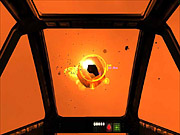
Independence War 2 is naturally similar to its predecessor in many ways, but the developer also made some significant changes to the original's design. Instead of limiting gameplay to a linear series of scripted missions, Independence War lets you take the role of a pirate who can freely explore an expansive star system, looting merchants and destroying enemy factions. For years, space sim fans have been looking for another free-form game like Elite or Privateer, and the only game that's come close was X: Beyond the Frontier. Even that game's potential wasn't truly realized until it was supplemented by an expansion pack, which was never released in North America, and even then the game lacked an involving overall storyline. Independence War 2 provides both an elaborate, open-ended environment and a meaty plot to unfold.
The game is set long after the war for independence that formed the basis for the plot of the original game. The central government has lost much of its influence to large corporations that leveraged their discovery of new technology to gain power. Independent settlements are being overrun by the evil corporations, which are effectively turning most of the population into slave laborers. Your character's desire to confront the corporations is primarily motivated by revenge, not altruism, as one of the corporate leaders ruthlessly slaughtered his father. To avenge your father's death, you'll have to gain a reputation through pirating and align yourself with various factions that will request your aid. There are plenty of well-produced cinematics that advance the plot, including an introduction that rivals the original game's opening in length, if not quality. The AI construct of Jefferson Clay, a famous starship captain who also served as a mentor in the original game, makes a welcome return, and your small group of companions has a lot of character. You can both control how rapidly you advance the plot and the order in which you embark on a number of missions, but the plot is occasionally cartoonish when compared to the civil war backdrop of the original game. The main villain, in particular, is so unrelentingly malevolent in such an over-the-top manner that he's dull. Still, the story is constantly engaging, especially near the end of the game when all of your enemies are unveiled.
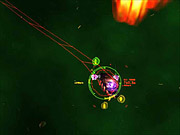
The original Independence War was renowned both for having more realistic physics than most space sims and for allowing you to pilot a larger craft than a fighter. Independence War 2 retains the realistic feel of its predecessor's physics system, although the effects of inertia have been made more manageable, and there aren't any annoying missions requiring you to overcome physics-based puzzles. In Independence War, you were given control of a medium-sized corvette, and you frequently had to switch perspectives between four different control stations. In the sequel, you still get to fly some sizeable ships, but you'll initially be limited to steering less intimidating craft than the original game's corvette. Ships also generally no longer have crews, as most ships are now flown by a single pilot. All of the flyable ships have a streamlined, consistent interface that lets you access the functions previously provided by the four different systems stations (command, navigation, engineering, and weapons) from a single perspective. While it's still useful to switch your view to an external perspective in certain situations, it's no longer mandatory to do so since the third-person perspective of the original game's weapons station has been abandoned. The streamlined controls are less effective at conveying the sense that you're in control of a sizeable vessel, but they are much easier to manage.
In fact, the interface is much more polished than it was in the original game. There are still some strange quirks, such as the fact that the default control bindings allocate three key joystick buttons to energy and missile weapons and yet you still can't fire them concurrently, but the new control system is generally both effective and unique. While combat in most space sims frequently devolves into turning battles with combatants frantically circling to focus guns on similarly thrashing opponents, battles in Independence War 2 play out differently. The controls borrow elements more commonly found in first-person shooters. Adept players will commonly use side strafing, since one of the best ways to maneuver to avoid missiles is to use side thrusters, and disable inertial-dampening thrusters so that they can attack in one direction while they are traveling on a different course. Battles can also occur at tremendous speeds, since you can constantly accelerate your velocity, although exceeding the limits imposed by nearby stations invites additional grief from nearby patrols. Fleeing to a less vulnerable position is also a constant tactical maneuver.
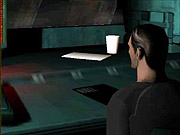
Independence War 2 is perhaps the only space sim that effectively conveys the immense distances involved in intra- and interstellar travel. The only manageable way to travel sizeable distances is through engaging an LDS (or, linear-displacement drive system), which lets you travel exponentially faster. At high LDS speeds, your craft will speed by beautifully rendered planets and suns. If you effectively use your LDS drive, you'll be almost unbeatable, since you can rapidly, completely repair even hull damage--but enemies frequently use missiles that will prevent you from engaging your LDS drive, and all installations will also generate their own anti-LDS fields. You can also travel even faster to certain destinations using jump gates called Lagrange points, provided that your ship is equipped with a capsule engine drive. Stealth is also often important in certain situations--there are a number of ways you can adjust your power settings or otherwise configure your ship to minimize the ability of other vessels to detect you.
While the heads-up display in the original game was relatively clunky, it's been significantly streamlined and improved in Independence War 2. Whenever your ship is moving, grid lines will appear on the screen to ensure that you can easily determine your ship's course. Your HUD also causes nearby ships to produce contrails, allowing you to instantly establish where the vessels are traveling. The grid lines and contrails displayed on the HUD work efficiently and don't obscure your view as much as they did in the original game. Other than the predominately useless radar orb, the HUD displays a great deal of information well and lets you focus on making tactical decisions.
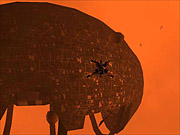
While music was largely omitted in the original game, Independence War 2 makes extensive use of its high-quality soundtrack. The graphics are crisp and colorful, and capable of being rendered in very high resolutions--although the HUD doesn't also scale, so it's less readable at sharper resolutions. You'll get ample opportunity to enjoy the graphics as well, since you'll constantly travel by different interstellar phenomena, and external views are useful in a number of situations. The game also automatically changes to a third-person perspective "director mode" whenever your ship docks, or otherwise interacts, with another object. The individual ships aren't quite as large as some of the capital ships in other recent space sims such as FreeSpace 2, or at least they seem less imposing because your ship is frequently traveling at tremendous speeds. But the ships are rendered in great detail, so much so that you can actually zoom in to get a clear view of your pilot. There are lots of other excellent graphical touches, such as the game's detailed explosions and the stone chips that splinter off from asteroids just before they're blasted to rubble.
The trading aspects of the game are simplistic, and you can only acquire a small fleet of wingmen, but it's still addictive to raid transports for items that let you improve your ships. Each item you acquire can be recycled, used to better equip your own small fleet of vessels, or traded for more useful items. There are dozens of different weapons, pieces of equipment, and other cargo items that you can acquire or manufacture, and the more effective you are as a privateer, the easier you'll find the scripted missions. It's worthwhile spending a significant amount of time acquiring better equipment, since some of the scripted missions are very difficult.
While it's generally pretty easy for even neophyte players to master the rudimentary skills necessary to play a space sim, Independence War 2 has a steeper learning curve, in spite of its good interface. The developer has done a good job at making the game more accessible than its predecessor, but Independence War 2 can still be a frustrating experience. For one thing, dogfighting can be very difficult--for instance, instead of having completely encompassing shields as in most space sims, your ships have individual shield deflectors that are only effective against one opponent at a time. Since ships are also fairly fragile, it's very easy to quickly be overwhelmed even when you previously were doing well in a battle. You'll find the game trying if you don't quickly acquire the abilities to assess potential threats and remain constantly aware of your opponents' actions.
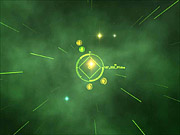
An even more significant cause of frustration is the mission scripting. While the mission goals are varied and interesting, the missions are too frequently puzzle-based. The original game occasionally required you to complete tasks in a precise order or manner, but Independence War 2's missions can be even more aggravating in this regard. Too often, the solutions to objectives are unintuitive. For example, in an early mission you'll be commissioned to steal some cargo from an enemy port. When you finally arrive at the port, you'll be given a cryptic clue suggesting that you should gain control of a remote drone, which you're able to pilot through your command menu. The manner in which you use the drone isn't apparent unless you grasp the significance of the clue, and even once you're aware of the solution it's very easy to inadvertently carry out the required procedure incorrectly unless you resort to using an external view of your vessel. Later missions contain objectives that are even more clearly intended to be puzzles. The inclusion of such puzzles seems misplaced, since they throw off the pacing of the otherwise enjoyable missions.
Those puzzles quickly become even more annoying once you realize how long it takes to travel back to where you previously were in a mission prior to being squashed. The expansion pack to the original game added mission save points to lengthier missions, to let you avoid constantly replaying parts of missions you'd already completed. That convenient feature wasn't included in Independence War 2, although you can sidetrack to your base during the course of a mission to save the game. Even then, however, it can take close to five minutes just to travel to a destination on the starmap to attempt to complete a mission that's consistently stumped you. While most of the time traveling around the map is enjoyable, the traveling won't be welcome when you're constantly required to retrace your steps just to try a different approach to solving a scripted puzzle.
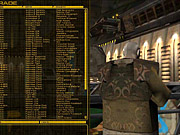
There are a few other ways in which the game could have been improved. It's not convenient to reprogram control keys, although you can do so by editing a text file. The actual pirating aspects of the game are simplistic and primarily just consist of camping out near a Lagrange point and stalking randomly encountered ships. While the central storyline is involving and contains at least one highly entertaining twist, it too frequently resorts to clichés, and the tone is generally less mature than that of the original game. All of those points are relatively trivial, however. The only significant concern is that the game can be frustrating, both because of its steep learning curve and its overreliance on mission puzzles, and even that concern is negligible when put in perspective to the achievements of the game.
The fact is, Independence War 2 is one of the most complex space sims ever, and almost every included feature works extremely well. It lets you stage multiplayer battles, which was a feature commonly requested by fans of the original game. The graphics are at least as good as any previously seen in the genre and are available at considerably higher resolutions than any previous space sims offered. You can easily play for days just exploring different solar systems and stealing or building enhancements to your ships. When you finally decide to advance the main plot, the varied mission goals and tactical challenges make the game constantly engaging. Independence War 2 is easily the best space sim since FreeSpace 2, and in several ways it exceeds that game. Particle Systems has successfully created the type of game that fans of the genre have been waiting for years to play.